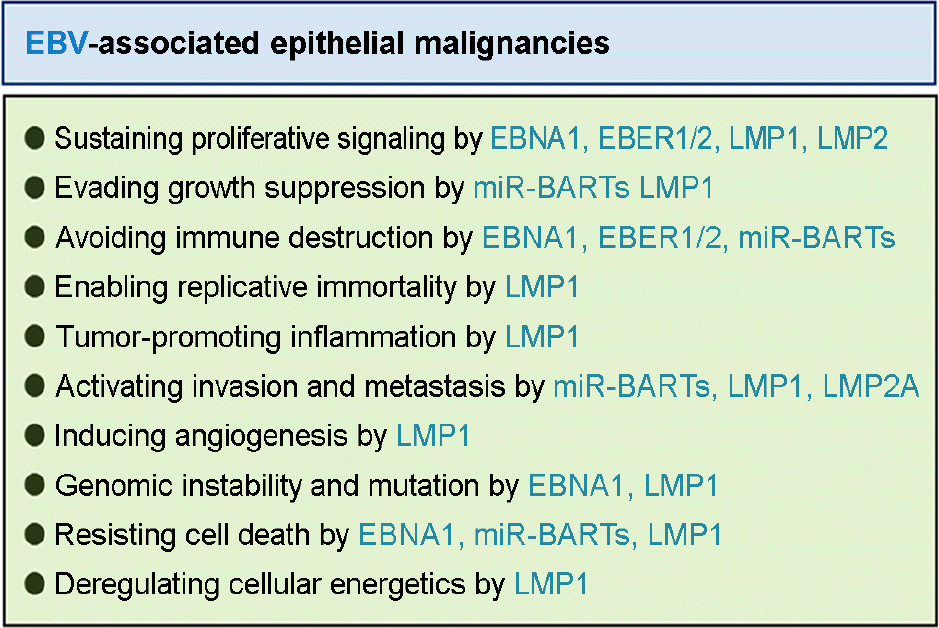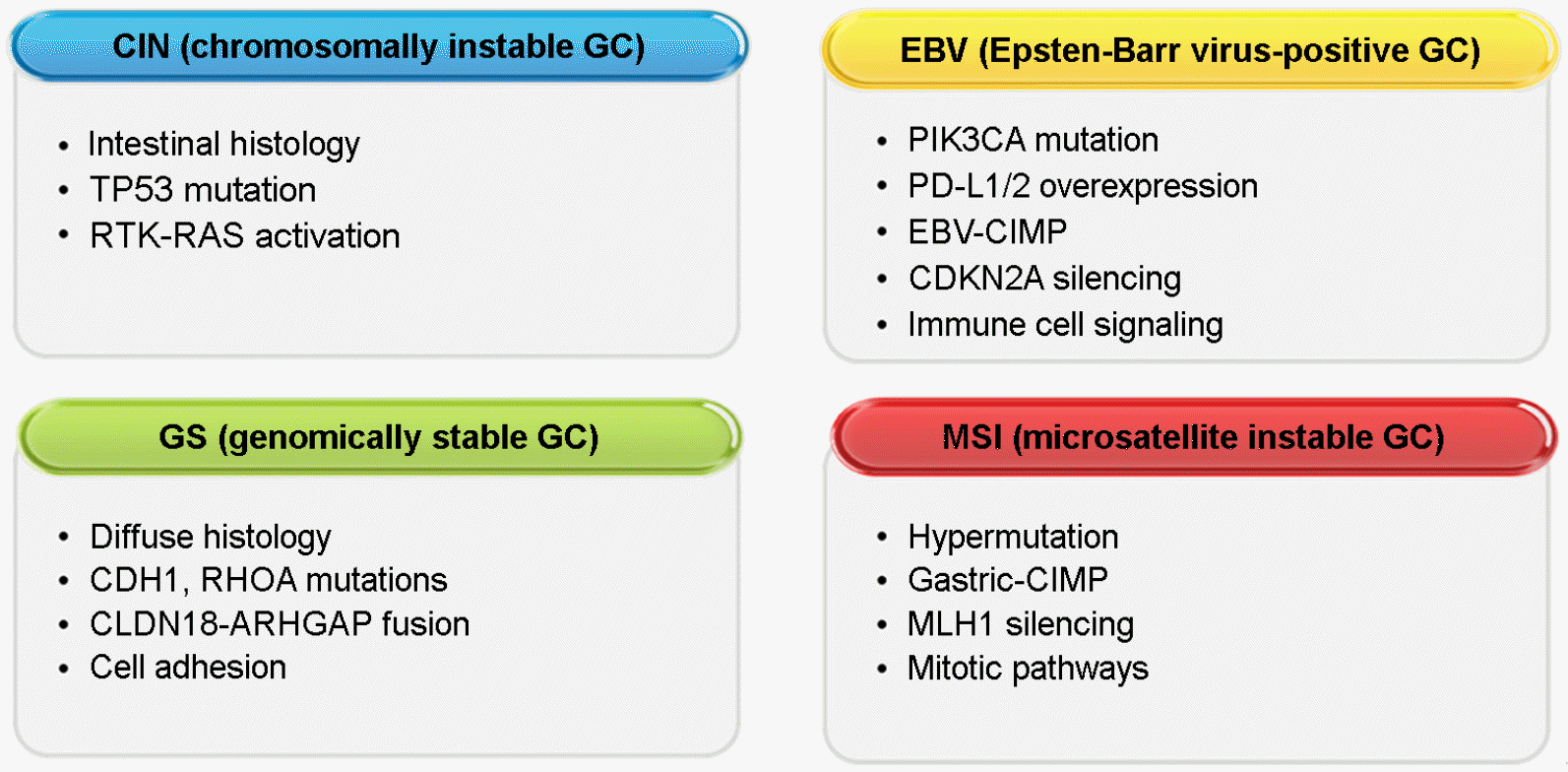Abstract
EBV infection has been causally associated with incidence of many carcinomas. EBV-associated gastric carcinoma (EBVaGC) has been classified as a unique gastric carcinoma subset, suggesting EBV infection is related to the development of gastric cancer. In this study, general trends of EBVaGC studies for last half-decades were reviewed in several perspectives of clinical significance, virological importance and etiological interests. Throughout this comprehensive reviewing, new study trends of EBV and EBVaGC for next half-decades were suggested.
Go to : 
REFERENCES
1). Tsao SW, Tsang CM, To KF, Lo KW. The role of Epstein-Barr virus in epithelial malignancies. J Pathol. 2015; 235:323–33.

2). Nishikawa J, Yoshiyama H, Iizasa H, Kanehiro Y, Nakamura M, Nishimura J, et al. Epstein-barr virus in gastric carcinoma. Cancers (Basel). 2014; 6:2259–74.

3). Cancer Genome Atlas Research Network. Comprehensive molecular characterization of gastric adenocarcinoma. Nature. 2014; 513:202–9.
4). Han J, He D, Feng ZY, Ding YG, Shao CK. Clinicopathologic features and protein expression study of Epstein-Barr virus-associated gastric carcinoma in Guangzhou. Zhonghua Bing Li Xue Za Zhi. 2010; 39:798–803.
5). Koriyama C, Akiba S, Shimaoka S, Itoh T, Akiyama S, Eizuru Y. Frequent expression of thymidine phosphorylase in Epstein-Barr virus-associated gastric carcinoma of diffuse type. Anticancer Res. 2010; 30:2431–7.
6). Sivachandran N, Dawson CW, Young LS, Liu FF, Middeldorp J, Frappier L. Contributions of the Epstein-Barr virus EBNA1 protein to gastric carcinoma. J Virol. 2012; 86:60–8.

7). Tobo T, Hirahashi M, Yao T, Aishima S, Oda Y. Ezrin expression and its phosphorylation in gastric carcinoma with lymphoid stroma and Epstein-Barr virus infection. Mol Clin Oncol. 2013; 1:220–4.

8). Chang MS, Kim DH, Roh JK, Middeldorp JM, Kim YS, Kim S, et al. Epstein-Barr virus-encoded BARF1 promotes proliferation of gastric carcinoma cells through regulation of NF-kappaB. J Virol. 2013; 87:10515–23.
9). Zhu S, Sun P, Zhang Y, Yan L, Luo B. Expression of c-myc and PCNA in Epstein-Barr virus-associated gastric carcinoma. Exp Ther Med. 2013; 5:1030–4.

10). Shinozaki A, Sakatani T, Ushiku T, Hino R, Isogai M, Ishikawa S, et al. Downregulation of microRNA-200 in EBV-associated gastric carcinoma. Cancer Res. 2010; 70:4719–27.

11). Marquitz AR, Mathur A, Shair KH, Raab-Traub N. Infection of Epstein-Barr virus in a gastric carcinoma cell line induces anchorage independence and global changes in gene expression. Proc Natl Acad Sci U S A. 2012; 109:9593–8.

12). Marquitz AR, Mathur A, Chugh PE, Dittmer DP, Raab-Traub N. Expression profile of microRNAs in Epstein-Barr virus-infected AGS gastric carcinoma cells. J Virol. 2014; 88:1389–93.

13). Kim RH, Chang MS, Kim HJ, Song KS, Kim YS, Choi BY, et al. Medical history and lifestyle factors contributing to Epstein-Barr virus-associated gastric carcinoma and conventional gastric carcinoma in Korea. Anticancer Res. 2010; 30:2469–75.
14). Li S, Du H, Wang Z, Zhou L, Zhao X, Zeng Y. Meta-analysis of the relationship between Epstein-Barr virus infection and clinicopathological features of patients with gastric carcinoma. Sci China Life Sci. 2010; 53:524–30.

15). BenAyed-Guerfali D, Ayadi W, Miladi-Abdennadher I, Khabir A, Sellami-Boudawara T, Gargouri A, et al. Characteristics of epstein barr virus variants associated with gastric carcinoma in Southern Tunisia. Virol J. 2011; 8:500.

16). Luo B, Liu M, Chao Y, Wang Y, Jing Y, Sun Z. Characterization of Epstein-Barr virus gp350/220 gene variants in virus isolates from gastric carcinoma and nasopharyngeal carcinoma. Arch Virol. 2012; 157:207–16.

17). Chen JN, Jiang Y, Li HG, Ding YG, Fan XJ, Xiao L, et al. Epstein-Barr virus genome polymorphisms of Epstein-Barr virus-associated gastric carcinoma in gastric remnant carcinoma in Guangzhou, southern China, an endemic area of nasopharyngeal carcinoma. Virus Res. 2011; 160:191–9.

18). Cheng N, Hui DY, Liu Y, Zhang NN, Jiang Y, Han J, et al. Is gastric lymphoepithelioma-like carcinoma a special subtype of EBV-associated gastric carcinoma? New insight based on clinicopathological features and EBV genome polymorphisms. Gastric Cancer. 2015; 18:246–55.

19). Kim do N, Seo MK, Choi H, Kim SY, Shin HJ, Yoon AR, et al. Characterization of naturally Epstein-Barr virus-infected gastric carcinoma cell line YCCEL1. J Gen Virol. 2013; 94:497–506.
20). Ku JL, Kim KH, Choi JS, Kim SH, Shin YK, Chang HJ, et al. Establishment and characterization of six human gastric carcinoma cell lines, including one naturally infected with Epstein-Barr virus. Cell Oncol (Dordr). 2012; 35:127–36.

21). Saito M, Nishikawa J, Okada T, Morishige A, Sakai K, Nakamura M, et al. Role of DNA methylation in the development of Epstein-Barr virus-associated gastric carcinoma. J Med Virol. 2013; 85:121–7.

22). Liu X, Wang Y, Wang X, Sun Z, Li L, Tao Q, et al. Epigenetic silencing of WNT5A in Epstein-Barr virus-associated gastric carcinoma. Arch Virol. 2013; 158:123–32.

23). He D, Xiao L, Chen JN, Liang Q, Shao CK. Correlation of Fas/FasL expression to cell apoptosis in Epstein-Barr virus-associated gastric carcinoma. Chin J Cancer. 2010; 29:283–7.
24). Lee JM, Kim H, Noh SH, Lee WY, Kim SJ, Park JH. Expression of Epstein-Barr Virus Gene and Clonality of Infiltrated T Lymphocytes in Epstein-Barr Virus-associated Gastric Carcinoma. Immune Netw. 2011; 11:50–8.

25). Strong MJ, Xu G, Coco J, Baribault C, Vinay DS, Lacey MR, et al. Differences in gastric carcinoma microenvironment stratify according to EBV infection intensity: implications for possible immune adjuvant therapy. PLoS Pathog. 2013; 9:e1003341.

26). Song HJ, Srivastava A, Lee J, Kim YS, Kim KM, Ki Kang W, et al. Host inflammatory response predicts survival of patients with Epstein-Barr virus-associated gastric carcinoma. Gastroenterology. 2010; 139:84–92.

27). Huang SC, Ng KF, Chen KH, Hsu JT, Liu KH, Yeh TS, et al. Prognostic factors in Epstein-Barr virus-associated stage I-III gastric carcinoma: implications for a unique type of carcinogenesis. Oncol Rep. 2014; 32:530–8.

28). Shin HJ, Kim do N, Lee SK. Association between Epstein-Barr virus infection and chemoresistance to docetaxel in gastric carcinoma. Mol Cells. 2011; 32:173–9.

Go to : 
 | Figure 1.
Oncogenic events to induce EBV-associated epithelial malignancies by EBV latent gene products. EBV gene products (in blue) induce malignancies by interrupting several anti-tumor activities and promoting various diverse oncogenic events in EBV infected epithelial cells. |
 | Figure 2.
Important characteristics of gastric carcinoma subtype. Gastric carcinoma (GC) were classified into four subgroups such as chromosomally instable GC, Epstein-Barr virus (EBV)-positive GC, genomically stable GC, and microsatellite instable GC. In particular, EBV-positive GC showed mutation in PIK3CA, overexpression of PD-L1/2, silencing of CDKN2A, and etc. EBV-CIMP and RTK stand for CpG-island methylation phenotype and receptor tyrosine kinase, respectively. |




 PDF
PDF ePub
ePub Citation
Citation Print
Print


 XML Download
XML Download